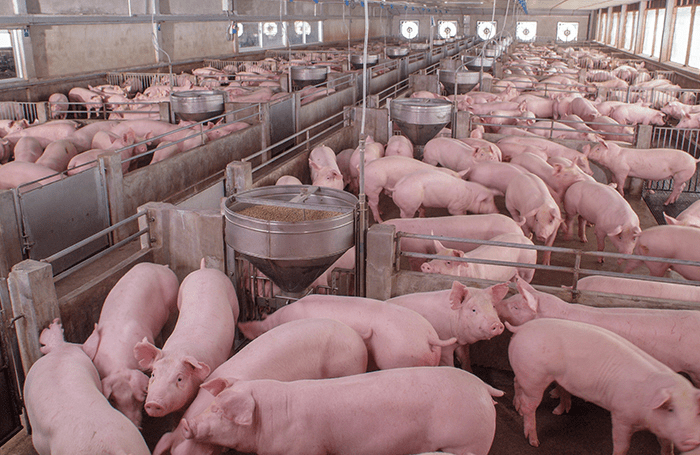By the 8-9 weeks of age, the growing pig is over the stress of weaning, and its digestive system will be competent to deal with a range of protein and energy sources, some 80% of the food used in a pig unit is consumed by the growing and finishing pigs, therefore the efficiency of food utilization during this phase is a crucial factor affecting profitability.
The management system which is adapted must relate to the specific objectives of each unit and these may range from home consumption of a cheap carcass as possible to the production of sophisticated bacon products.
These considerations dictate the type of pig to be produced. Feeding and management must be geared to optimize performance. The small-scale rural producer, for example, will attempt to maximize the use of cheaper, lower-quality feedstuffs.
It must be remembered, however, that the growing pig has only a limited ability to digest and utilize fiber in the diet and too much bulky food may depress growth to such an extent as to render its inclusion uneconomic.
Under commercial conditions, different priorities may be given to factors such as food conversion efficiency and food cost per pig growth rate, carcass leanness, and grading according to the relative economic advantages they confer on the whole production unit.
Read Also: Complete Piglets Management Tips and Care Guide
Culling of Pigs (Sows)

To maintain overall productivity in the herd, it is important to have a culling policy so that sows are removed at the correct time. The reasons for culling include;
Lameness, another injury, farrowing problems, poor litter size, poor mothering ability, and low fertility.
A sow that regularly produces a good litter will eventually start to decline with age, probably around her tenth litter if she is producing well, a good guide is to allow her to remain in the herd until her performance falls below the average of the gilts in the herd.
At the same time, it is important to have a supply of pregnant gilts available to replace sows that need to be culled.
Read Also: Proper Management of Pig Breeding Stocks, Piglets, Weaners, Growing, and Finishing Pigs
In conclusion, proper management of each class of pigs on the farm is essential for the profitability of the herd. The farmer must make every effort to ensure that the well-being and productivity of his animals are achieved.
Consideration for management of pigs includes a) stockman ship which refers to the relationship between the farmer and his pigs. b) Handling and restraint: The necessity of restraint arises because, unfortunately, all the animals do not reciprocate your love for them. c) Hygiene:
This is one of the important aspects of pig farming to prevent infection and ensure success and profitability.
Boars are selected following performance testing to ensure the efficient performance of their offspring. This include, a faster growth rate than average with less back fat than average, It has utilized its feed more efficiently as a result of producing less fat, must have two equally sized and firmly suspended testicles, and with good sexual libido also good conformation, strong straight feet, and good temperament.
A boar should not start serving until he is over eight months of age; and during the first two months of service, only twice per week. Subsequently, he can be used for up to six services per week.
Overworking a boar will reduce the quality f the sperm produced, leading to small litters and an increased number of sows returning to service. The standard recommendation is one boar to 20 sows and gilts.
Piglets should be provided with warmth in the form of beddings made up of wood shavings or hay. In humid areas, they should be put in a well-ventilated pen. Farmers should make sure their piglets have taken colostrums ‘the first milk’ which is rich in various nutrients and antibodies except for iron and copper.
Young piglets from 10 days onwards should have a high protein diet available to them. This has to be fed in a small creep (creep feeding) or area where the mother cannot eat the feed.
Weaning is the separation of a young piglet from its mother with the aim of stopping them from suckling milk. This could take place between 4 to 6 weeks of their life. At this age, the piglets will eat feed and fend for themselves.
By the 8-9 weeks of age, the growing pig is over the stress of weaning, and its digestive system will be competent to deal with a range of protein and energy sources some 80% of the food used in a pig unit is consumed by the growing and finishing pigs, therefore the efficiency of food utilization during this phase is a crucial factor affecting profitability.
Read Also: Guide to Proper Management of Piglets
Read Also: How to Develop an Effective Waste Management Strategy
